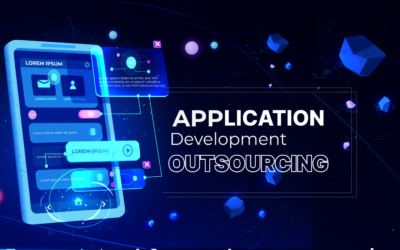Trends in Digital Transformation for Mid-Sized Enterprises

In the ever-evolving landscape of technology, mid-sized enterprises are at a pivotal juncture. Digital transformation has become not just a buzzword but a necessity for businesses to thrive and stay competitive. In this blog, we will delve into the top seven emerging trends in digital transformation tailored specifically for mid-sized enterprises.
As the business world reshapes itself, these trends offer a roadmap for mid-sized companies to navigate the digital transformation journey effectively. We’ve broken down these trends into simple, easy-to-understand concepts to help you make informed decisions that can steer your company towards success.
From leveraging artificial intelligence to embracing cloud computing, these trends are designed to enhance efficiency, boost productivity, and foster innovation while keeping costs in check. We will explore the impact of data analytics, the growing importance of cybersecurity, the significance of customer-centric approaches, and how mid-sized enterprises can harness the power of the Internet of Things (IoT) to their advantage.
This blog aims to equip you with the knowledge and insights necessary to embrace these transformative trends, empowering your mid-sized enterprise to thrive in the digital age. Join us on this exciting journey of discovery as we unlock the secrets to a prosperous digital future for your business.
What are the 7 emerging trends in digital transformation?
1: Increased Adoption of Artificial Intelligence (AI) and Machine Learning (ML) technologies:
Today, customers don’t see speed, efficiency, and personalization as just nice-to-haves. They actually want every business to be good at these things. But here’s the thing: doing this is too hard for people alone. To make it happen, businesses have to use AI and machine learning in their digital plans.
And you know what? The numbers also show that AI and machine learning are getting more popular. Fortune Business Insights says:
- The global Machine Learning (ML) market is expected to expand from $26.03 billion in 2023 to a substantial $225.91 billion by 2030. This shows a strong growth rate of 36.2%.
- The global Artificial Intelligence (AI) market is forecasted to increase from $515.31 billion in 2023 to a remarkable $2,025.12 billion by 2030, demonstrating a growth rate of 21.6%.
AI and machine learning can be powerful allies for mid-sized businesses in their digital transformation journey. Here’s how:
- Automation for Efficiency: These technologies can handle repetitive and time-consuming tasks, saving both time and labor costs for the company.
- Data-Driven Decision-Making: AI and machine learning excel at processing and analyzing vast amounts of data. They help decision-makers by identifying patterns, predicting market trends, and providing valuable insights.
- Personalized Customer Experiences: By analyzing customer data and behavior, AI can assist in tailoring experiences.
- Improved Customer Support: AI can enhance customer support by efficiently handling routine customer inquiries, leaving human agents to deal with more complex and sensitive issues.
Mid-sized businesses are getting smarter with AI, like chatbots, to boost customer service. These clever chatbots do a great job in helping customers, answering common questions, and guiding them to the right info. They only bring in human help when it’s really needed, which saves time and money.
Here are other examples of mid-sized enterprises using AI and machine learning:
Using Big Data analytics to foresee market trends and make smart choices is crucial. When we look at past data and how customers behave, smart computer programs can guess what people might want to buy, find new chances to sell stuff, and set the right prices. All of this helps companies improve their sales plan fast, leading to better sales and more money coming in.
AI programs study what customers like and buy before to suggest products just for them. By doing this, companies can display things that customers are likely to want, which can boost their sales.
2: The Rise of Low-Code, No-Code:
The rise of low-code and no-code tools is a big deal these days. Gartner, a well-known research firm, says that the low-code and no-code field is worth a whopping $13.8 billion. And guess what? By 2024, more than 65% of all software development will be done using these easy-to-use platforms.
Here’s why low-code no-code is so popular:
- Low-code and no-code tools are like tech magic for people who don’t know much about programming. They let anyone, even if they’ve had only a bit of training, make cool stuff.
- These tools are super easy to get, make building stuff fast, and save you a lot of money.
- They have features that make building software way easier, like having a personal assistant for coding.
Mid-sized enterprises looking for digital transformation:
- Reduced time-to-market
- Lower development costs
- Empowerment of citizen developers
How Mid-Sized Enterprises Benefit from Low-Code and No-Code Platforms in Digital Transformation:
- Creating customer-facing applications to improve the customer experience, increase sales, and reduce costs.
- Automating mundane business processes to streamline, reduce costs, and free up employees to focus on more strategic tasks.
- Creating interactive dashboards and reports that consolidate data from various sources.
- Building Chatbots and virtual assistants to enhance customer support, address FAQs, and automate routine interactions. It increases response time and improves customer support.
- More Focus on App Modernization:
In recent times, many companies have realized that old-fashioned, outdated software can slow down their progress and make it tough to come up with new ideas. That’s why they’re making a switch to modernizing their apps.
Here’s how app modernization helps mid-sized enterprises:
- Improve performance as modernized apps are faster than legacy applications.
- Increase agility as enterprises can easily update and modify modernized applications.
- Enhanced security since modernized applications are more secure as they can regularly update with the latest security patches and features.
- Reduced costs as modernized applications are more efficient and easier to maintain.
The challenges that mid-sized enterprises can face when modernizing their apps:
- Old Code: Some older applications are written using outdated programming languages and frameworks. This can make it hard and costly to make them better.
- Data Migration: When you update your apps, you usually have to move your data to new systems. This can be tricky and takes a lot of time.
- Integration: Upgraded apps often need to work together with other systems. It’s hard because those systems often use different tech and rules.
- Cost: Upgrading your apps can be expensive. Before starting, mid-sized companies should think about how much it will cost and what they’ll gain from it.
- Risk: Upgrading your apps can be risky. If you don’t plan and do it right, it can cause downtime, losing data, and other issues.
4: Greater attention to customer experience:
In today’s digital world, where businesses are vying for customers, companies are putting more effort into making customers happy. They’re not only interested in providing an easy experience but also making it special by tailoring it to what each customer likes.
Here are a few strategies that a mid-sized enterprise can implement:
- Use customer data platforms (CDPs) to bring together all your customer information in one place. When you keep all the data safe and organized, it’s simpler to study it and make useful decisions.
- Consistently collect customer input via surveys, feedback forms, and social media channels to enhance the overall customer experience.
- Deliver a cohesive experience across every customer interaction point, be it in physical stores, the online realm, mobile platforms, or social media channels.
- Employ loyalty initiatives such as discounts, promotions, and exclusive offers to motivate and reward devoted customers.
- Ensure customer satisfaction by reaching out to them post-purchase, offering support, and sharing relevant resources tied to their acquisition.
5: Increased Focus on cybersecurity:
As an increasing number of companies transition their data to the cloud, the importance of data privacy and security has risen significantly. Consequently, businesses are prioritizing cybersecurity and implementing robust measures for data privacy and security.
Here’s why cybersecurity is essential for mid-sized enterprises:
- Inadequate data privacy and security measures frequently result in data breaches, substantial financial losses, and harm to reputation.
- Neglecting data security can lead to international compliance challenges, potentially leading to substantial fines and sanctions.
With the rise of hybrid work arrangements, the importance of cybersecurity has surged. Unauthorized data sharing, phishing scams, and cyberattacks have presented significant challenges for businesses in their efforts to protect their privacy.
Here’s how mid-sized enterprises can improve their cybersecurity:
- Reducing the likelihood of attacks can be achieved by ensuring your software remains current.
- Keep a vigilant eye on your network to detect any signs of suspicious behavior, like unauthorized login attempts or irregular data traffic.
- Implement security precautions such as firewalls, intrusion detection systems, and data encryption to safeguard your company’s data.
- Instruct your staff on cybersecurity and optimal procedures.
6: More enterprises embrace the Cloud:Over the last few years, cloud computing has surged as a prominent trend in the realm of digital transformation. According to findings from McKinsey, a significant shift is expected, with the majority of businesses directing a staggering 80% of their IT budget towards cloud solutions by 2024.
Here’s why mid-sized enterprises are adopting Cloud Computing:
- Shifting to the cloud yields cost savings by reducing expenses associated with hardware, software, and maintenance.
- Enhanced flexibility is achieved through the cloud’s scalable and elastic infrastructure, enabling swift adaptation to evolving circumstances for businesses.
- Mid-sized enterprises can safeguard their data and applications effectively by utilizing the extensive security features and services offered by the cloud.
- Cloud service providers present a plethora of cloud-based solutions and offerings, enabling mid-sized businesses to accelerate their innovation efforts efficiently.
challenges mid-sized enterprises may face while embracing the cloud:
- Cloud security is a paramount worry for businesses. While cloud service providers provide an array of security functionalities, it’s crucial for enterprises to comprehend the potential security hazards and implement essential measures for risk reduction.
- While utilizing cloud service providers can simplify mid-sized enterprise operations, it’s crucial to exercise caution to avoid becoming ensnared in vendor lock-in. Consequently, they may find themselves unable to transition to a different service provider in the event of dissatisfaction with the service or if the current provider ceases operations.
- Certain cloud providers might satisfy only a portion of the required compliance standards, leading to potential compliance hurdles for mid-sized enterprises.
- Cloud computing may lead to higher expenses compared to conventional on-premises IT infrastructure, potentially placing financial strain on certain mid-sized businesses.
- Automation takes centre stage:
Automation, a burgeoning digital transformation trend, has gained significant momentum this year. As per Salesforce, a staggering 95% of IT and engineering leaders have made it their top priority. The goal is to dismantle organizational silos, elevate the customer experience, and supercharge productivity. Furthermore, automation has been a boon for employee satisfaction, with an impressive 89% of workers expressing greater contentment thanks to automation solutions.
Here’s how automation helps them:
- Streamlining business processes
- Reducing manual labor and unnecessary expenses
- Improving both employee productivity and organizational efficiency
In brief, automation presents abundant prospects for mid-sized enterprises seeking enhanced productivity. Through reduced time spent on routine chores and a heightened emphasis on meaningful activities, these businesses can provide added value to their customers.
Here are a few ways mid-sized enterprises can implement automation:
- Robotic Process Automation (RPA): Harnessing bots for the automation of routine, rule-bound activities such as data input, invoice handling, report creation, and addressing customer support queries.
- Optimizing Efficiency: Employing workflow automation solutions for the creation and control of automated procedures, such as task routing, approval processes, and notifications.
- Enhancing Customer Support: Leveraging Chatbots and Virtual Assistants for Automated Customer Interaction, Efficient Query Resolution, and 24/7 Support.
- Streamlining Your Marketing Efforts: Harness the Power of Marketing Automation Platforms for Efficient Marketing Campaigns, Email Marketing, Lead Generation, and Customer Segmentation.
- Sales Automation: Enhance Lead Tracking, Deal Management, and Forecasting with Sales Process Automation.
- Streamlining IT Operations: Enhancing efficiency by automating tasks such as server provisioning, software updates, and system monitoring within IT operations.
- Automate Data Integration and ETL for Improved Analytics: Streamline your data integration and ETL (Extract, Transform, Load) procedures to centralize data from multiple sources, guaranteeing data precision and enhancing analytical capabilities.
challenges enterprises may face while automating business processes:
- Automating operations that depend on data from numerous unconnected data silos can pose considerable challenges for organizations.
- Effective automation demands a unique set of expertise and know-how. Consequently, companies must either recruit proficient personnel or seek external assistance
- Automation represents a substantial investment, requiring a significant commitment of both financial resources and time.
- Resistance to change and a reluctance to automate workflows could be encountered among certain staff members.
- Improperly managed automation can give rise to security vulnerabilities that might result in expensive data breaches.
Conclusion:
In conclusion, these seven emerging digital transformation trends offer mid-sized enterprises a clear path to success. By embracing AI, cloud computing, data analytics, cybersecurity, customer-centric strategies, and IoT, businesses can enhance efficiency, productivity, and innovation while keeping costs in check. The digital age offers exciting opportunities, and with the right strategies, mid-sized enterprises can thrive. Stay informed, adapt, and unlock the potential of these trends to propel your business into a prosperous future. Remember, the key to success lies in understanding and applying these trends to your unique business needs. Don’t miss out on the digital revolution!
Are you looking for any IT Services such as Web design and Development, Professional/Staff Augmentation Services, Cloud Computing, Mobile App Development, Digital Marketing Services and more? Connect Stridefuture Technology, which helps to meet your requirements.
{StrideFuture Technology, a full-service company specializing in Software Solutions and Consultancy services. We specialize in Personal, Business, IT Services, Web design and Development, Mobile App Development, Digital Marketing Services, and much more you can dream Virtually with us! Reach out for more service at StrideFuture Technology.}









